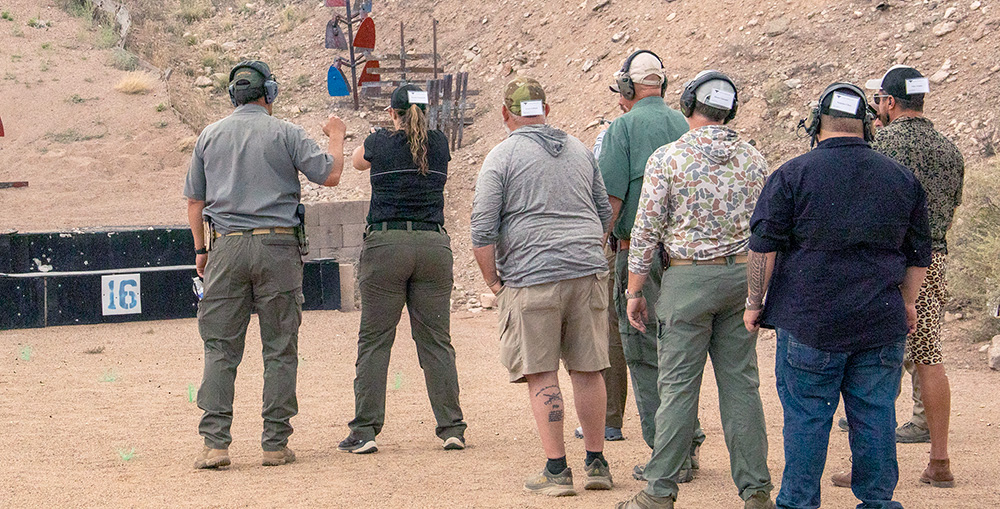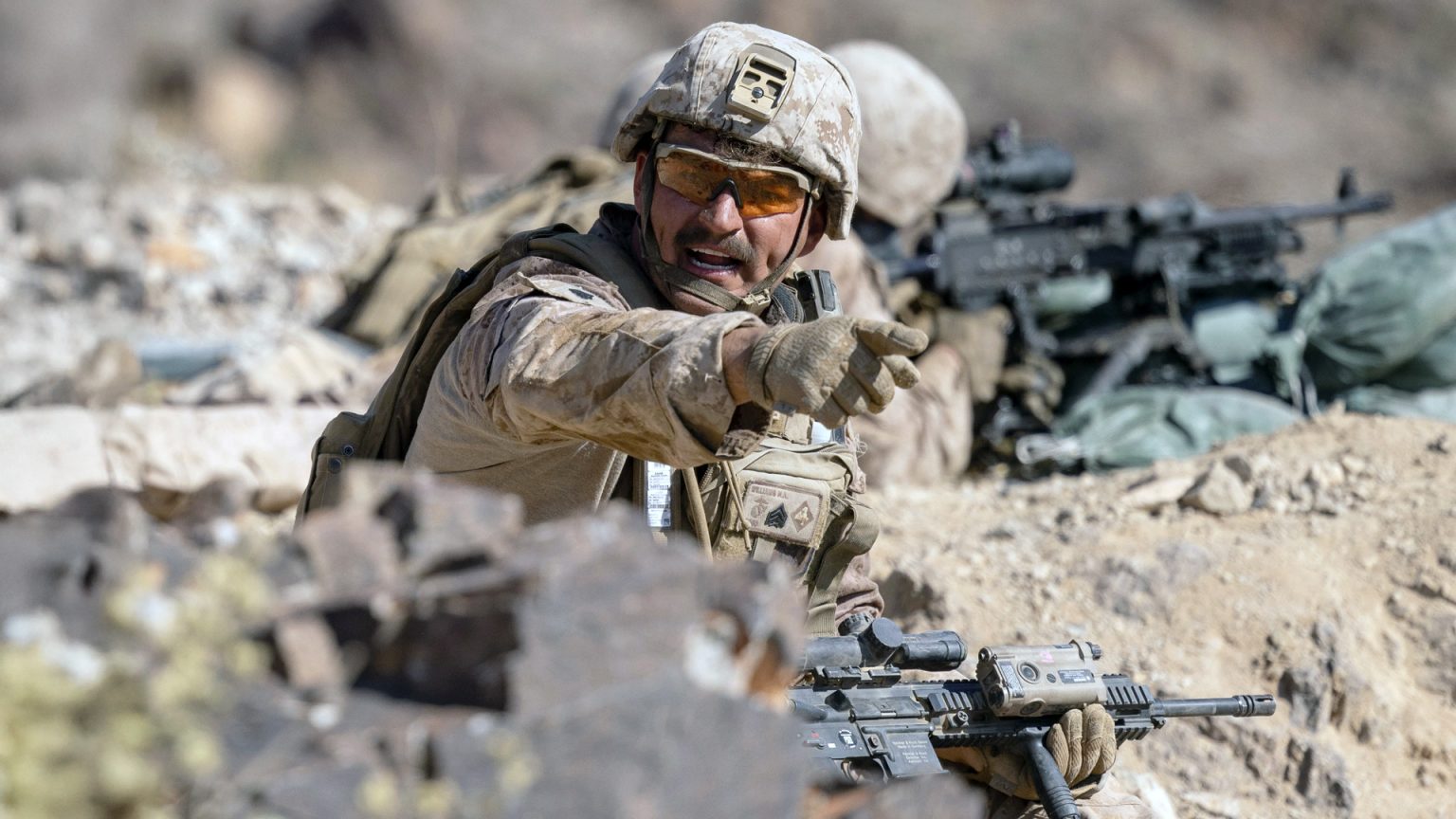The late Louis Awerbuck taught that surviving a gunfight is 95-percent luck. We can’t control the attacker’s skills, cunning or the stray bullet that has our name on it. We may react perfectly, moving tactically as we empty our magazine into the threat’s vital areas, each a mortal wound. But, in that dying reflex, he or she may fire and fatally wound us—unfortunately, all ties in a gunfight go to the other guy.
While control in a gunfight might be limited, don’t despair. Our purview of control includes our skill development, familiarity with self-defense law (permissions and boundary limits of deadly force), decision-making (avoidance as well as shoot/no-shoot situations) and last, but certainly not least, increasing our mental and emotional armor to help us better perform in the worst moments of our lives.
The mechanics of hitting a target on demand are important for self-defense. Skill development involves both dry-fire practice at home as well as some regular shooting on a square range. Occasional professional instruction never hurts, either. However, highly experienced military operators know that surviving a gunfight is generally more about controlling one’s emotions in the middle of chaos and fear than it is about raw shooting ability.
Is it possible to condition ourselves to competently respond to any potential combative needs? Since 1988, I’ve been teaching a simple method of connecting our shooting skills with our emotional reactions to sudden, imminent, deadly threats. The feedback on this training method has been very positive from those who later prevailed in their shootings.
Freeze, Flight, Fight
Let’s begin at the beginning of self-defense: fear of physical harm. The inherent survival responses of “freeze, flight or fight” are a mammalian reaction to the realization of sudden threat. All animals initially freeze when suddenly alerted to danger, including apex predators (that would include us). Everyone freezes to some degree when the unexpected happens—think meerkats at the first hint of alarm or deer in the headlights. Freezing at sudden, possible danger is not a character issue. It is instinctual and universal, requiring time to orient to sudden change. We tend to stop, immediately turn and look in the direction of the alarm, then hold perfectly still until we can figure out what’s going on. The next natural response is flight: fleeing from danger. Fighting tends to be the last response of animals, including most humans.
Training can assist in more quickly transitioning through the freeze state into the fight—but only if the training is relevant to its application to real-world threats. While not fighting is always preferable, developing the capability of a rapid fighting response is necessary for those unavoidable dangers we might face.
When suddenly startled from close range, we react. A “startle reaction” simultaneously elicits the following:
Our heads will immediately snap to the direction of that surprise, eyes wide and pupils dilated.
We gasp, taking in a sharp intake of air, our bodies preparing for flight or fight. Most people hold their breath following the initial gasp (stillness).
Whether your subconscious chooses fight or flight as its automatic response, how you deal with everything after the stimulus is up to you
Our bodies pivot, orienting our chest to that threat, reflexively lowering our center of gravity and adopting an athletic stance (much like a basketball player), with our dominant-side foot back a bit and our torsos slightly leaning forward from the waist.
Our hands tend to come up to jaw level, palms out, with our non-dominant hand slightly forward.
Our shoulders rise, moving up and forward while our chin sinks a bit to better protect our extremely vulnerable throat and neck.
We freeze, unmoving, until we determine what the immediate threat is.
What’s going on here? A part of the brain, the amygdala, acts as the first filter of external stimuli entering the brain. Even before we consciously recognize something (say a thin, long, coiled shape on the ground), the filter of our amygdala causes us to jump back and away well before our rational brain recognizes it to be a garden hose rather than a dangerous snake.
Fear causes the levels of cortisol and adrenaline in the blood to increase, prompting changes in heart and breathing rates, blood distribution, vision, hearing and muscle tone. It can result in the bladder and/or bowels involuntarily voiding. It also creates psychological changes in pain tolerance, focus, cognitive flexibility and adaptation, as well as memory and perceptual distortions. When we become truly fearful, our emotional response changes our body and mind, decreasing our ability to apply the skills we have so carefully built. We become more clumsy and less able to perform fine-motor skills, like shooting accurately.
Fear generates responses from areas of the brain separate from our practiced motor skills. Our amygdala’s screening response alerts to possible danger, flooding our bodies with hormones. The amygdala is not reasonable, nor is it rational. It simply interprets a possible danger instantly and sends an alarm to which the body reacts. The good news is it can learn (it is a key part of how our long-term memory works). Through proper training, our amygdala response can help prepare us to transition through fear and better apply our skills when responding to sudden threats.
While we cannot stop the freeze response, we can train to function better during the emotionally based fear response that degrades actual performance. Here’s the cool part: mimicking the physical response to sudden threat—the startle response—activates to some degree the emotional fear response. Push-ups and running sprints before shooting don’t do it. Being yelled at won’t, either. Emotional conditioning can take place by simulating the body’s reaction to fear, linking that response to our shooting skills. Our job is to intentionally create that link between fear and our physical shooting skills, generating a familiar cue for the recall of shooting skills.
Creating the link between fear and skill
Having sufficient experience to automatically respond to imminent threats and be less affected in your skill levels requires you to have already lived through enough threatening situations to create familiarity with your survival response. For the rest of us, training must condition us to transition to a functional level of skill and emotional resiliency. We create this link by engaging our imagination while physically mimicking the body’s fear response when initiating our weapon presentation/firing sequence.
How do we put this into practice? First, imagine the face of the last person you thought was going to injure you. Almost everyone can conjure someone’s scary face, even if there was no actual threat from the individual. Though I’ve been shot at in several instances (and, gratefully, missed), the individual I choose to imagine was a parolee named “Corey,” who spent three hours painfully demonstrating on me the training on how to defeat police that he received in prison. I’m certain he would willingly kill me—or anyone—without a second thought.
Imagine that person you chose standing before you as you prepare to shoot. Rather than shooting “paper targets,” imagine this person attempting to harm you, then firing and hitting to stop him or her from murdering you and yours. Each round fired will be at this threatening person while “believing” you are in a life-and-death shooting.

Attending formal training classes will go a long way toward preparing you for whatever happens, especially if your skills are tested against other students.
Next, I use the firing command of “Threat!” to initiate fire. It’s short for “imminent deadly threat” (or that behavior to which we are legally justified to respond with deadly force). It seems yelling, “Imminent deadly threat!” on the range elicits strange looks from folks. Who knew? In life, recognition of a dire threat is what is going to initiate our responding with gunfire during a self-defense shooting to save our lives.
At “Threat!” take a quick, sharp intake of breath while widening your eyes, jerking your shoulders up and lowering your center of gravity. Rather than reaching up and out with both hands, immediately move your shooting-hand to grip your handgun while reaching with your support-hand to clear concealment (clothing). This physical action combined with the sharp breath intake and imagined threat of that individual you are imagining creates an emotional tie to the shooting response (along with generally a mild adrenaline dump). Every round fired is emotionally tied to saving your life. Our minds then associate sudden threat with moving, drawing and hitting the threat, transitioning from freezing and causing a physical reaction that prepares us to respond as a survival strategy.
Humans aren’t machines, even though most of the training we undergo treats us as if we just need to be given a specific sequence of physical actions and all will come together when suddenly faced with being murdered. Human beings are far more subject to their emotional programming than many care to admit—except those who have actually lived through a shooting.
Thankfully, we are not routinely required to function in a state of peak fear in this country. Conversely, this general safety doesn’t prepare us for our best efforts when we need them most. Anything we can do to safely accustom ourselves to the effects of fear while performing necessary survival skills will pay dividends.
General George S. Patton stated, “Discipline must be a habit so ingrained that it is stronger than the excitement of battle or the fear of death.” We can safely condition ourselves to operate more competently through a simple method where the normal emotional response is tied to the proper physical reaction, assisting us in responding more competently in high-threat situations. By mentally picturing a deadly assailant while simulating the physical response to overwhelming emotions, by thinking, “Threat!” we may be better able to function in a more disciplined manner to win in that 5 percent of the fight we might better control.
Read the full article here








